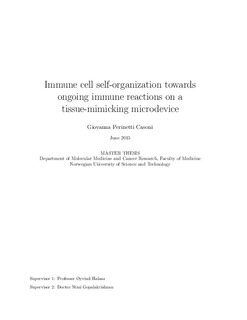| dc.description.abstract | A tissue mimicking micro-device has been developed by our microfluidics group. The device
has been designed in order to mimic complex in vivo scenarios of immune cell recruitment,
where cells sense and are directed by soluble and structural signals in confined spaces. A
maze-structured network of microchannels is connected to cell culture chambers where immune
reactions can take part. Immune reactions represent a source of chemoattractants molecules
for creating functional gradients across the network, possibly recruiting cells from other compartments.
The device is composed of a patterned structure of polydimethylsiloxane (PDMS),
an organisilane elastomeric polymer, bonded on a glass coverslid.
In this work, our newly designed fourth generation device has been tested under several experimental
conditions studies in order to determine its critical points in the study of cell
chemotaxis. First, some of the microfabrication operations necessary for the realization of the
chip have been expanded and partly translated to the biology laboratory. Good microfabrication
procedures have been proved to be fundamental for the functionality of the device,
since a good bonding between the micropatterned PDMS and the glass is crucial to spatially
control the flow of chemoattractant molecules. Second, a preliminary characterization of diffusion
dynamics within the device was perfomed. The design fits the creation of gradients
across the mazed-structured network, but gradients seem to require time to be established.
Some suggestion are therefore proposed in order to accelerate this process, such as increased
dimensions of the attractor culture chambers, that are likely to help in the accumulation of
more chemokine-producing cells. In any case, some results suggest that established gradients
may be maintained during prolonged time inside the network.
The device was then employed in biological experiments showing potential recruitment of
bone marrow-derived dendritic (BMDC) cells. These cells invaded the network under certain
experimental conditions and clearly localized towards the source of chemoattractant molecules.
The long time needed for gradient formation and a degree of unpredictability of the dynamics
in antigen-presentation reactions ongoing on-chip, did not demonstrated active recruitment of
CD8+ and CD4+ T cell hybridomas. T cell hybridomas showed thought a high motility inside
the device and interactions between them and BMDC have been documented in real-time.
Moreover, the design fits the employement of several microscopy techniques that can be used
to address diverse questions regarding mechanisms regulating cells’ routes and potentially (not
present in this work) subcellular events during migration. The design was proven to organize
the space surrounding migrating cells in a manner that is easily accessible to tracking and
modeling techniques. Temporal components of migration still need to be fully elucidated and
will require further work, also by coupling established biological assays, in order to fully benefit
from device potentialities. | nb_NO |
